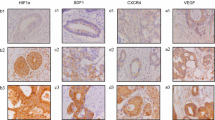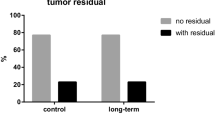Abstract
Background
High levels of vascular endothelial growth factor (VEGF) in ovarian cancer metastases are associated with a worse prognosis in patients treated with chemotherapy. VEGF-directed therapy improves survival for those with metastatic colorectal cancer. Patients with mucinous adenocarcinomas metastatic to the peritoneal surfaces can be treated with cytoreductive surgery, and both tumor grade and cytoreduction status are prognostic. We hypothesized that angiogenic indices may be prognostic in patients undergoing cytoreductive surgery for mucinous adenocarcinoma of the appendix and colon.
Methods
Cytoreductive cases from a 5-year period from the University of Cincinnati peritoneal malignancy database were reviewed. CD 34 counts (blood vessels) and VEGF expression was evaluated by means of immunohistochemistry on specimens from patients undergoing cytoreductive surgery and intraperitoneal hyperthermic perfusion (IPHP) for mucinous adenocarcinoma.
Results
A total of 26 males and 9 females, with a mean age of 50 years, underwent cytoreductive surgery and IPHP for mucinous adenocarcinoma of appendiceal (n = 32) or colonic (n = 3) origin. With a mean follow-up of 18 months (range 1–63 months), 23 had disease recurrence and 12 were alive without recurrence. The mean survival was 19 months (range 1–63 months). CD34 counts did not correlate with recurrence or survival; however, average VEGF counts correlated with survival (P = 0.017), and, for patients with recurrence, this correlation was stronger (P = 0.002).
Conclusions
These results suggest that markers of tumor angiogenesis may predict survival in patients with peritoneal surface metastases from mucinous adenocarcinoma. These findings provoke the hypothesis that antiangiogenic therapies may be effective in patients with this devastating disease.



Similar content being viewed by others
Reference
Limber GK, King RE, Silverberg SG. Pseudomyxoma peritonaei: a report of ten cases. Ann Surg 1973; 178:587–93
Mann WJ Jr, Wagner J, Chumas J, Chalas E. The management of pseudomyxoma peritonei. Cancer 1990; 66:1636–40
Glehen O, Mohamed F, Sugarbaker PH. Incomplete cytoreduction in 174 patients with peritoneal carcinomatosis from appendiceal malignancy. Ann Surg 2004; 240:278–85
Gough DB, Donohue JH, Schutt AJ, et al. Pseudomyxoma peritonei. long-term patient survival with an aggressive regional approach. Ann Surg 1994; 219:112–9
Sugarbaker PH, Chang D. Results of treatment of 385 patients with peritoneal surface spread of appendiceal malignancy. Ann Surg Oncol 1999; 6:727–31
Sugarbaker PH. Cytoreductive surgery and peri-operative intraperitoneal chemotherapy as a curative approach to pseudomyxoma peritonei syndrome. Eur J Surg Oncol 2001; 27:239–43
Sugarbaker PH. New standard of care for appendiceal epithelial neoplasms and pseudomyxoma peritonei syndrome? Lancet Oncol 2006; 7:69–76
Miner TJ, Shia J, Jaques DP, Klimstra DS, Brennan MF, Coit DG. Long-term survival following treatment of pseudomyxoma peritonei: an analysis of surgical therapy. Ann Surg 2005; 241:300–8
Culliford AT,4th, Brooks AD, Sharma S, et al. Surgical debulking and intraperitoneal chemotherapy for established peritoneal metastases from colon and appendix cancer. Ann Surg Oncol 2001; 8:787–95
Witkamp AJ, de Bree E, Kaag MM, van Slooten GW, van Coevorden F, Zoetmulder FA. Extensive surgical cytoreduction and intraoperative hyperthermic intraperitoneal chemotherapy in patients with pseudomyxoma peritonei. Br J Surg 2001; 88:458–63
Deraco M, Baratti D, Inglese MG, et al. Peritonectomy and intraperitoneal hyperthermic perfusion (IPHP): a strategy that has confirmed its efficacy in patients with pseudomyxoma peritonei. Ann Surg Oncol 2004; 11:393–8
Takahashi Y, Kitadai Y, Bucana CD, Cleary KR, Ellis LM. Expression of vascular endothelial growth factor and its receptor, KDR, correlates with vascularity, metastasis, and proliferation of human colon cancer. Cancer Res 1995; 55:3964–8
Takahashi Y, Tucker SL, Kitadai Y, et al. Vessel counts and expression of vascular endothelial growth factor as prognostic factors in node-negative colon cancer. Arch Surg 1997; 132:541–6
Shaheen RM, Tseng WW, Vellagas R, et al. Effects of an antibody to vascular endothelial growth factor receptor-2 on survival, tumor vascularity, and apoptosis in a murine model of colon carcinomatosis. Int J Oncol 2001; 18:221–6
Hurwitz H, Fehrenbacher L, Novotny W, et al. Bevacizumab plus irinotecan, fluorouracil, and leucovorin for metastatic colorectal cancer. N Engl J Med 2004; 350:2335–42
Loggie BW, Fleming RA, McQuellon RP, Russell GB, Geisinger KR. Cytoreductive surgery with intraperitoneal hyperthermic chemotherapy for disseminated peritoneal cancer of gastrointestinal origin. Am Surg 2000; 66:561–8
Ahmad SA, Kim J, Sussman JJ, et al. Reduced morbidity following cytoreductive surgery and intraperitoneal hyperthermic chemoperfusion. Ann Surg Oncol 2004; 11:387–92
Ahmad SA, Liu W, Jung YD, et al. The effects of angiopoietin-1 and -2 on tumor growth and angiogenesis in human colon cancer. Cancer Res 2001; 61:1255–9
Takahashi Y, Bucana CD, Akagi Y, et al. Significance of platelet-derived endothelial cell growth factor in the angiogenesis of human gastric cancer. Clin Cancer Res 1998; 4:429–34
Zebrowski BK, Liu W, Ramirez K, Akagi Y, Mills GB, Ellis LM. Markedly elevated levels of vascular endothelial growth factor in malignant ascites. Ann Surg Oncol 1999; 6:373–8
Yoshikawa T, Tsuburaya A, Miyagi Y, et al. Up-regulation of hypoxia-inducible factor-1 alpha and VEGF mRNAs in peritoneal dissemination of patients with gastric cancer. Anticancer Res 2006; 26:3849–53
Osada R, Horiuchi A, Kikuchi N, et al. Expression of semaphorins, vascular endothelial growth factor, and their common receptor neuropilins and alleic loss of semaphorin locus in epithelial ovarian neoplasms: increased ratio of vascular endothelial growth factor to semaphorin is a poor prognostic factor in ovarian carcinomas. Hum Pathol 2006; 37:1414–25
Gadducci A, Viacava P, Cosio S, et al. Vascular endothelial growth factor (VEGF) expression in primary tumors and peritoneal metastases from patients with advanced ovarian carcinoma. Anticancer Res 2003; 23:3001–8
Author information
Authors and Affiliations
Corresponding author
Rights and permissions
About this article
Cite this article
Logan-Collins, J.M., Lowy, A.M., Robinson-Smith, T.M. et al. VEGF Expression Predicts Survival in Patients with Peritoneal Surface Metastases from Mucinous Adenocarcinoma of the Appendix and Colon. Ann Surg Oncol 15, 738–744 (2008). https://doi.org/10.1245/s10434-007-9699-7
Received:
Revised:
Accepted:
Published:
Issue Date:
DOI: https://doi.org/10.1245/s10434-007-9699-7




